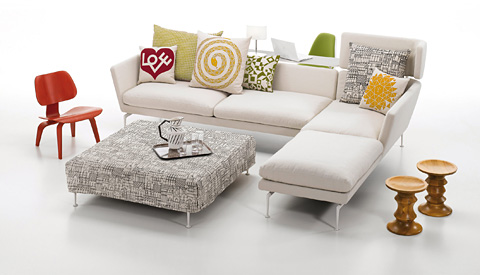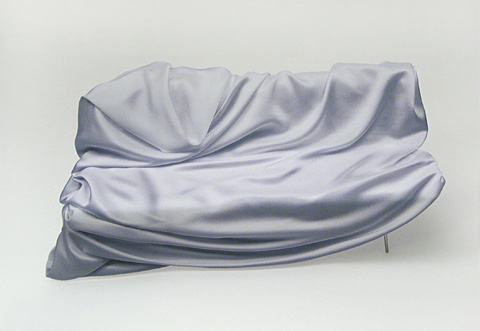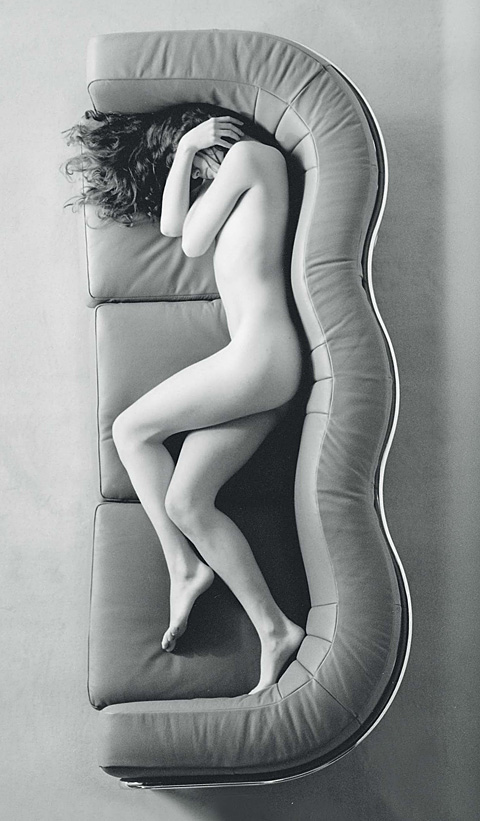An armchair is always single, an isolated item. But it is the sofa – whether as a stand-alone item or ensemble, that promotes community; you sit in a common area as if in the same boat. As art historian Martin Warnke ascertains, "the individual armchair renounces in the sofa its ceremonial solitary claim". In the "salon the sofa formed the programmatic core of an opened cell: It stood in the middle of the room's long wall and had individual armchairs placed alongside it against the same wall. As such, the group was exposed to the entire room and prepared for communication on all sides. (...)The ensemble, which was only one of the conversation possibilities distributed around the room, permitted free entrance and exit". As was once the case in the salon, today's seating ensembles also place seating rights and ranks at our disposal. And ever more frequently they feature in the so-called living room, which with its house bar integrated the pub and the concert hall with its hi-fi system, and stand facing the television as the media window on the globalized world. Only in interiors that have to satisfy higher standards does the open fire occupy this place and center the ensemble in a somewhat archaic fashion.
As regards typology the sofa proves problematic. If you exclude special cases or hybrid anomalies such as the sofa bed or the daybed, there are surprisingly few breaks to be found in its continuity. As such, the micrological structure of the typological classification is subject to subjective and functional criteria, is essentially arbitrary. A sofa that does not resemble a bench serves more or less for sitting and reclining – including all manner of intermediate levels of comfortable and relaxed resting. What remains, in other words the organization of relaxed sitting, is a question of taste and zeitgeist, materials employed and good finishing, i.e., refers to differences of individual examples that are formally and historically occasioned. Consequently, rather than being a chronology featuring individual breaks the typology of the sofa is more like a potpourri of individual solutions (together with occasional allusions to historical models).
Cube or freeform?
Let us therefore not attempt a chronology but begin with several contrasting models, which lie like stepping stones in the current of time and are not so much turning points or breaks in the sofa's development, but represent variations on the theme: On the one hand, we have the "LC2" by Le Corbusier, Jeanneret and Perriand, which basically copies the cubic armchair (citing Josef Hoffmann's "Kubus" armchair from 1910), the cushions are fixed and geometricized, and as such it refers to a rational construction of sitting. On the other, there is Isamu Noguchi's "Freeform Sofa", which in a free, biomorphic curve makes a sculptural intervention in space. With "Do-Lo-Rez" Ron Arad also takes up the cube as a basic element, but has it appear as a colorful pixel. Or George Nelson's "Marshmallow Sofa", born out of the spirit of Pop art, whose seat area is a colorful series of individual cushions, and the "Worker Sofa" by Hella Jongerius, which comes across as buttoned up and revives sitting upright. Or "Clou" by Wulf Schneider and Partner, which suspends the back and side rests on small cubes resembling dominos, while "Onda" by De Pas D'Urbino and Lomazzi sets Le Corbusier's cubes in an undulating motion and renders his order relative. Finally, a veritable extreme, we cannot omit Verner Panton's psychedelic living cavern "Phantasy Landscape Vision 2", which extends the sofa into a complete interior world in which you nestle as in a uterus and can adopt virtually any sitting or reclining position.
Not only along the wall
Another historical track is followed by sofa systems such as Tom Dixon's "Serpentine", Christophe Pillet's "Elysée" and Philipp Mainzer's and Farah Ebrahimi's "Shiraz". All of them seek a contemporary take on oriental sitting habits, but remove the traditional long upholstered benches from along the wall and relocate them as islands of comfort around the room. The "Polder Sofa" by Hella Jongerius and Piero Lissoni's "Alphabet" round out this typological sub-group. Even a modular seating system such as "Lava" by Studio Vertijet still plays with the same scheme, as does in principle "Extrasoft" by Piero Lissoni; "Circle" by Ben van Berkel, "Patchwork" by Pascal Mourgue and the "Place Sofa" by Jasper Morrison also fit into this group. Antonio Citterio's "Suita" that consists of a series of variants does not so much cite the elongated form of oriental sofas that can be extended at will but can if it is fitted out with tablets and foot sections just as easily wander to the center of the room.
Designed cushions
By contrast, "Le Bambole" by Mario Bellini is composed like a large cushion or unites several cushions to form a unit that comes over as somewhat inflated. This tendency of the cushion to become independent gives rise to a further typological subgroup. "Togo" by Michel Ducaroy has a similar composition to "Le Bambole". It seems to consist of a large cushion resting against the wall. By contrast, in "Cipria" Humberto and Fernando Campana have combined a host of different individual cushions covered in bright accentuating colors to form a unit, which makes a vague allusion to Nelson's "Marshmallows" but is less reminiscent of a serial order than a mountain of loose cushions. Even extravagant one-off items such as the "Quilt Sofa" and the "Ploum" by the Bouroullec brothers or the "Ottoman" by Noé Duchafour Lawrance are despite their difference in structure and appearance from a typology viewpoint primarily "large cushions".
As regards the encapsulating of open cells naturally we must mention the "Alcove" by the Bouroullec brothers, which above all in its "highback" version has for some time provided a touch of intimacy in the temporary public living areas of lounges, offices and lobbies, and consequently has been copied numerous times in recent years.
Sitting on metaphors
Gaetano Pesce has a totally different approach. He created furniture from metaphors, not unlike the lip-shaped sofa "Bocca" by Studio 65 inspired by arch-Surrealist Salvador Dalì. Accordingly, with "Tramonto a New York", "Notturno" or "Montanara" the sofa is transformed completely into an iconic object, which is to express perceptions and sensations. "Tramonto" depicts a sunset above Manhattan's high-rises, and in "Montanara" you sit as if on a waterfall and recline against snow-covered mountains. Similarly, in the case of "La Fiorita" Pesce engages in a comical and ingenious game with the metaphor. The furniture consists of lawn and earth complemented by cushions in the guise of colored blossoms.
In this category we can also place the experiments by designers at Front, which also works with the principle of the image or the trompe l'oeil. As the name "Soft Wood Sofa" suggests, a crude wooden bench actually proves to be a soft piece of upholstered furniture, and nature which is worked with a saw is transformed into a synthetic soft quotation in the interior. The "Draped Sofa", likewise by Front, looks like a single fold of fabric even though it is only an image of the same printed on fabric. Finally, "Cushion" presents itself like a collection of cushions tossed into the air and captured there as a photo, so that it would fit the typography of "cushions" equally well.
Under wraps
While not resorting to optical illusions a similar approach is employed by Konstantin Grcic, the man who often emphasizes his preference for chairs because they offer him greater freedom of movement. His first sofa designed for Established & Sons bears the name "Cape", because the cover was conceived as a loose throw of the kind you find in hotels or apartments that are temporarily uninhabited, where the furniture is draped with covers. In "Cape" you can even choose between a heavy, soft, warm cover for the winter, a light fabric for the summer, and a third one that is somewhere in-between. In this manner the sofa conceals its amorphous shape and basically itself, and keeps its secret under wraps like Marcel Duchamp's typewriter under the cover, which is labeled "Underwood". A similar, though not so well perfected approach is taken by Francesco Binfaré in "Gran Khan".
Historical festivals
Here and there the one or other historical element or detail recurs in contemporary interpretation, not only as regards the sofa frames. For example, Alessandro Mendini's "Kandissi" reveals just how much he and other representatives of the Alchimia group, and not least of all the revolutionaries of Memphis, were intent on a revision of historical patterns. You can say the same of Hans Hollein's post-modern "Marilyn".
We find reminiscences to the time of Louis XVI., Louis-Philippe and the salons of the Enlightenment in "Bess" by Stefan Diez in which small cushions can be arranged in front of a thin, shell-shaped backrest, and in Inga Sempé's "Ruché", in which a stitched cover hangs over a rectangular wooden frame. Jaime Hayon's latest creation, the "Favn" sofa, not only embodies the Danish word that gave it its name and means "embrace", but also boldly cites the sofa's erotic component and the curving backrests of models such as we know from the Empire. Even Jasper Morrison refers to historical models with "Three Sofa de Luxe Chaiselongue" as does Ron Arad in his "Victoria& Albert" sofa.
Simply classic
In a totally different classically modern manner the elegant "William" by Damian Williamson cites the oriental mattresses stacked on top of each other. We have already referred to Antonio Citterio – who together with Piero Lissoni is one of the most inventive sofa designers and understands how to set different accents in various subgroups of the typological classification – and his "Suita", with which he perfected the customized transformation of the sofa. And we should also mention "Moov" by Piero Lissoni, which combines a basically rational-geometrical composition with casual cushions and "Mex Cube", which accentuates almost identical elements, but without – like LC – needing a frame that holds them together. Furthermore "John-John" by Jean-Marie Massaud and "Noe" by Lievore Altherr Molino also belong in this category to which we could add many other examples.
In the end, a totally different solution for the problem of sitting and reclining is presented. Designed by Noé Duchaufour Lawrance, it takes to the floor once again. Her "Tapis Plis", which seems to be nothing but a flat rug, can be folded up at the edges, thus creating a backrest. Which finally brings the landscape of seating down to earth once again with a bump.
Find a comprehensive overview of sofas here:
› Sofas at Stylepark
Already published in our series on product-typologies:
› "Everything that is furniture" by Thomas Wagner
› "Do not lean back!" on stools by Nina Reetzke
› "On tranquility and comfort" on lounge chairs by Mathias Remmele
› "Foam meadow, stays fresh for longer" by Markus Frenzl
› "In Chair World" by Sandra Hofmeister
› "All the things chair can be" by Claus Richter
› "The shelf – furniture for public order" by Thomas Edelmann
› "How the armchair got its wings…" by Knuth Hornbogen
› "Pillar of society" by Thomas Edelmann
› "The rocking chair as a phenomenon for the arcades" by Annette Tietenberg
› "The small world of multi-functional furniture" by Nancy Jehmlich
› "Now stop jumping on the bed! The bed as a place for work, rest and play" by Annette Tietenberg
› "It's set" on tables by Sandra Hofmeister
› "The Couch. A psychoanalytical fantasy" by Thomas Wagner
› "A chair for 40 hours" by Mathias Remmele
 Tom Dixon's „Serpentine“ for Moroso
Tom Dixon's „Serpentine“ for Moroso
 Christophe Pillets „Elysée“
Christophe Pillets „Elysée“
 Philipp Mainzers und Farah Ebrahimis „Shiraz“ für e15
Philipp Mainzers und Farah Ebrahimis „Shiraz“ für e15
 „Polder Sofa“ by Hella Jongerius for Vitra
„Polder Sofa“ by Hella Jongerius for Vitra
 Piero Lissoni's „Alphabet“ for Fritz Hansen
Piero Lissoni's „Alphabet“ for Fritz Hansen
 „Lava“ by Studio Vertijet for COR
„Lava“ by Studio Vertijet for COR
 Suita Sofa by Antonio Citterio for Vitra
Suita Sofa by Antonio Citterio for Vitra
 „Bocca" by Studio 65 for Heller
„Bocca" by Studio 65 for Heller
 La Fiorita by Gaetano Pesce
La Fiorita by Gaetano Pesce
 Montanara by Gaetano Pesce for Meritalia
Montanara by Gaetano Pesce for Meritalia
 Draped Sofa by Front
Draped Sofa by Front
 Moment Collection by Front
Moment Collection by Front
 „Marilyn“ by Hans Hollein for Poltronova
„Marilyn“ by Hans Hollein for Poltronova
 „1330 WILLIAM Chaise Longue“ by Damian Williamson for Zanotta
„1330 WILLIAM Chaise Longue“ by Damian Williamson for Zanotta
 „Favn“ by Jaime Hayon for Fritz Hansen
„Favn“ by Jaime Hayon for Fritz Hansen
 „Tapis Plis“ von Noé Duchaufour Lawrance
„Tapis Plis“ von Noé Duchaufour Lawrance
 Josef Hoffmann's „Kubus“ for Wittmann
Josef Hoffmann's „Kubus“ for Wittmann
 „Freeform Sofa“ by Isamu Noguchi for Vitra
„Freeform Sofa“ by Isamu Noguchi for Vitra
 „1030 ONDA Sofa“ by Paolo Lomazzi, Jonathan De Pas, Donato D´Urbino for Zanotta
„1030 ONDA Sofa“ by Paolo Lomazzi, Jonathan De Pas, Donato D´Urbino for Zanotta
 Phantasy Landscape Vision 2 by Verner Panton, photo: Archiv der Bayer AG
Phantasy Landscape Vision 2 by Verner Panton, photo: Archiv der Bayer AG
 Phantasy Landscape Vision 2 by Verner Panton, photo: Archiv der Bayer AG
Phantasy Landscape Vision 2 by Verner Panton, photo: Archiv der Bayer AG
 „Le Bambole“ by Mario Bellini for B&B Italia
„Le Bambole“ by Mario Bellini for B&B Italia
 „Togo“ by Michel Ducaroy for Ligne Roset
„Togo“ by Michel Ducaroy for Ligne Roset
 Cipria by Humberto Campana, Fernando Campana for edra
Cipria by Humberto Campana, Fernando Campana for edra
 „Quilt" by Ronan Bouroullec, Erwan Bouroullec for Established & Sons
„Quilt" by Ronan Bouroullec, Erwan Bouroullec for Established & Sons
 Ploum by Ronan Bouroullec, Erwan Bouroullec for Ligne Roset, photo: Nina Reetzke, Stylepark
Ploum by Ronan Bouroullec, Erwan Bouroullec for Ligne Roset, photo: Nina Reetzke, Stylepark
 Cape by Konstantin Grcic for Established & Sons, photo: Dimitrios Tsatsas, Stylepark
Cape by Konstantin Grcic for Established & Sons, photo: Dimitrios Tsatsas, Stylepark
 Cape by Konstantin Grcic for Established & Sons, photo: Dimitrios Tsatsas, Stylepark
Cape by Konstantin Grcic for Established & Sons, photo: Dimitrios Tsatsas, Stylepark
 Francesco Binfaré's „Gran Khan“ for edra
Francesco Binfaré's „Gran Khan“ for edra
 „Ruché“ by Inga Sempé for Ligne Roset, photo: Thomas Wagner, Stylepark
„Ruché“ by Inga Sempé for Ligne Roset, photo: Thomas Wagner, Stylepark
 Ron Arad's „Victoria& Albert“ für Moroso
Ron Arad's „Victoria& Albert“ für Moroso
 „Bess“ by Stefan Diez for e15
„Bess“ by Stefan Diez for e15









